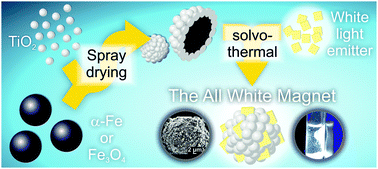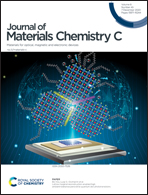An all white magnet by combination of electronic properties of a white light emitting MOF with strong magnetic particle systems†
Abstract
A multi-component particle system was developed that combines the properties of white color, white light emission and strong magnetism on the macroscopic and microscopic scale. The system is constituted by combination of an inorganic white core with either hard or soft magnetic properties and a white light emitting MOF. The key towards this achievement is the supraparticulate character constituted by a magnetic core, of either magnetite or α-Fe, surrounded by titania and silica nanoparticles of a certain size in a loose structural shell-arrangement as white components and finally the white light emitting metal–organic framework (MOF) EuTb@IFP-1 as building blocks of a core–shell structure. The supraparticles are created by forced assembly of the inorganic compounds and by combining spray-drying and postsynthetic modification by solvothermal chemistry. Thereby, the gap is bridged that homogenous compounds are either strongly magnetic, white in appearance or white light emitting. The composites presented herein inherit these properties intrinsically as electronic properties. The white characteristics are based on all optical properties that enable white: light reflection, refraction, and light emission. This work shifts the paradigm that strong magnetic materials are always expected to be intrinsically dark.



 Please wait while we load your content...
Please wait while we load your content...